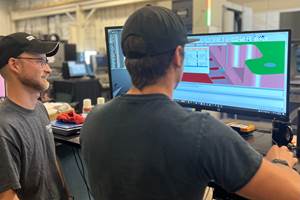CAD/CAM Eases the Move to 5-Axis Machining for Moldmaker
Automotive moldmaker that handles molds up to 40 tons says Sescoi’s WorkNC helped ease its introduction to 5-axis machining with its effective global roughing strategies; smooth, powerful finishing; speed and ease; reduction in EDM operations; and, shop floor programming. Today it has four licenses, including two 5-axis for its machining applications.
Automotive moldmaker that handles molds up to 40 tons says Sescoi’s WorkNC helped ease its introduction to 5-axis machining with its effective global roughing strategies; smooth, powerful finishing; speed and ease; reduction in EDM operations; and, shop floor programming. Today it has four licenses, including two 5-axis for its machining applications.
Sridevi Tool Engineers is one of the leading moldmaking companies in India, and Sescoi’s WorkNC has helped it in the introduction of 5-axis machining, according to Abhay Churi, Assistant Manager CAM and CNC at Sridevi. The company was formed in 1972 and can handle molds up to 40 tons and specializes in the automotive, white goods and engineering markets. Located in Thane, India, it has 12 CNC machines, including two 5-axis, and six EDM machines and currently produces about 180 molds each year.
Effective global roughing strategies: Sridevi first installed WorkNC in 2004 and it is satisfied with the features and support of the system. It now has 4 licenses including two 5-axis for its machining applications. Churi says, "WorkNC’s Global Roughing strategies are very effective with lots of options. The holder collision check lets us identify what we can safely machine, and the rest roughing identifies where material is remaining enabling us to rapidly remove the large amounts of metal common in the bumper and door molds we produce. For roughing we usually start with an 80mm r8 radius or 66mm r8 and then work down to a 1mm ball."
Smooth, powerful finishing: For finishing, the company has some advanced machinery including a DMG DMC 105VL linear & 75 VL which has 5-axis capability and spindle speeds of up to 28,000 rpm. Churi says, "WorkNC has some powerful finishing strategies. We normally cut the P20 material at between 10 and 20,000 rpm, running 24 hours per day 6 days per week. WorkNC knows where there is excess material and its smooth strategies, which are very effective at the high feedrates we use, eliminate the danger of excessive tool loading and hence damage to the cutter."
Auto 5 is fast and easy: Mold design is mainly completed in Unigraphics and model data is reliably transferred into WorkNC using IGES/XT. Some of the cavities are very large, so the speed of the software is important to the company. To produce 5-axis cutterpaths, the company uses WorkNC’s Auto 5 module. This makes it very simple to generate continuous and safe 5-axis paths. Churi says, "We much prefer using WorkNC for 5-axis programming as it is quite easy. In WorkNC Auto 5, the programmer simply creates a 3 or 3+2 axis toolpath and the software automatically changes it into 5-axis, bringing 5-axis machining well within the capabilities of nearly every company."
Reduction in EDM operations: By implementing 5-axis machining, Sridevi has been able to dramatically reduce the number of electrodes it needs to manufacture. Arvind Gadad, Assistant Manager CAM & CNC, explains, "Reducing EDM was our main driver for introducing 5-axis machining as this saves us a lot of time, increasing the number of molds we can make each year."
Shop floor programming: The ease of use of WorkNC allows the company to train its CAM programmers in-house. It is starting to train its machine operators as well, to increase their flexibility and skill levels, and they are already producing their own programs on the shop floor for the more simple parts. Mr. Arvind Gadad says, The support we get from Sescoi is very good, and it resolves any queries we have quickly.
Related Content
Five-Axis Vertical Mill Increases Mold Shop Capacity by Reducing Setups
Zero Tolerance now processes blocks — from squaring to waterline drilling to rough and finish milling — on a single five-axis CNC mill, reducing setups and moving blocks in/out of multiple machines without sacrificing accuracy and surface finish.
Read MoreCAD/CAM Software Reduces Delivery Times by 70% With a Six-Month ROI
Single integrated CAD/CAM package reduces translation errors, simplifies design process, improves shop efficiency and shortens tool lead times.
Read MoreLarge Hybrid Steel Insert Solves Deformation, Dimensionality, Cycle Time Problems
DMLS printers using metal additive powders selected by Linear AMS to produce high-quality, accurate, consistent 3D-printed mold components with certification and traceability.
Read MoreIntegrated CAD/CAM Streamlines Electrode Manufacture, Improves Quality
A focus on electrode design and automation helps toolroom improve efficiency, reduce tooling costs and deliver higher quality products.
Read MoreRead Next
How to Use Continuing Education to Remain Competitive in Moldmaking
Continued training helps moldmakers make tooling decisions and properly use the latest cutting tool to efficiently machine high-quality molds.
Read MoreReasons to Use Fiber Lasers for Mold Cleaning
Fiber lasers offer a simplicity, speed, control and portability, minimizing mold cleaning risks.
Read MoreHow to Use Strategic Planning Tools, Data to Manage the Human Side of Business
Q&A with Marion Wells, MMT EAB member and founder of Human Asset Management.
Read More


















